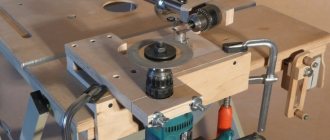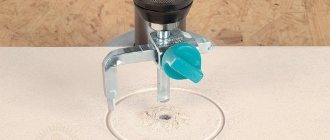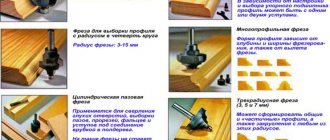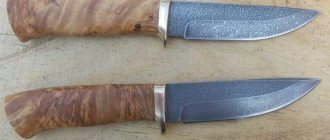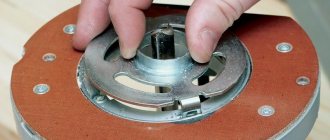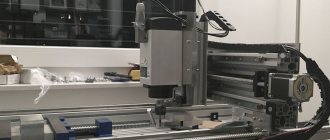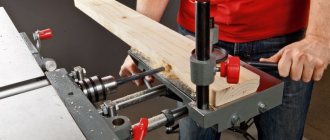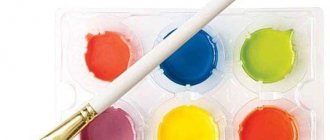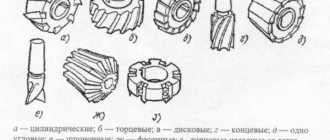Sometimes after work there are broken drills left, which can not be thrown away, but used to make a wood cutter. This device is perfect for making blind holes in wood for bearings. This homemade product will be especially useful and relevant for furniture manufacturers at home. If you strictly follow the action plan outlined in this article, you can get a good cutter. But you shouldn’t place high hopes on it, since a purchased carbide spiral cutter is much better. And for regular work, a homemade tool is not suitable; it is recommended to buy high-quality tools.
Extension cord for feather drill.
There's a problem.
It is necessary to drill timber walls at the dacha with a 22mm tip drill (for electrics). The thickness of the wall including the cladding is 17-19cm. A regular feather drill allows you to drill to a depth of approximately 13cm. An extension cord is required. Couldn't find it for sale anywhere in Moscow. Many sellers don’t even know that such things exist. Question: Is it possible to use a bit extension as a drill bit extension? Do they have the same mounting dimensions? There are different feather drills. Others fit perfectly into adapters. Only an adapter like the one in the picture will be inconvenient - it will not hold the drill when removed, the drill will remain in the wall. Needed with fixation. There are other feather drills, they will generally hang too loosely in the 1/4″ adapter.
Leroy-Merlin sells extension adapters for Anchor drill bits. 59 rubles, length - about 20 cm.
.. can’t you just use a spiral one?? without any adapters.. Length up to 450.. yes, there are also short ones like 20 cm. They pass the tree perfectly..
2Dmitriy65 You need to look at the markets. There are 30cm extensions. True, they are from a series of one-offs and mostly in sets. Personally, I welded a piece of a pin. But there f35 had to be chewed 40cm.
Where, to the tail of the drill?
I also didn’t want to go to the store 20 km away. and here the welding is at hand (I assembled the heating), the drill costs a penny, grab it and go for it.
Not convenient. You will have to buy too many different sizes. And I don’t know if a screwdriver will pull it. I used Makita to drill with a diameter of 35 in 150 timber. It goes without problems, but the length is not enough.
Similarly, I bought a twist drill of the required size, the smallest 200 mm and welded it to the 10 mm fittings and got a twist drill 1 meter long. even if you want to find it, you won’t find it.
drilled ties for the formwork. There is 800 mm minimum size
I guess sometimes you have to get out of it.
I also drilled, but made do with a short (regular) metal drill.
So what's the point? Are the shanks of the drill bit and the bits different or the same?
Ruslan1111 wrote: you need to look at the markets. There are 30cm extension cords. True, they are from a series of one-time ones and mostly in sets.
I used this Enkor: the drill and extension are misaligned - the beating is crazy! Summary: cal.
Dmitriy65 wrote: So what's the point?
Anchor extension + Encor drill (as the most budget option). Or another drill that (the tail) will fit into the Anchor extension.
Give it up, for occasional one-time work, no problem. There are options for welding the reinforcement to the tail, and no one complains about the beating. And this is all done in a machine, in the centers.
How to lengthen a metal drill with your own hands
To lengthen a metal drill yourself, use one of three methods.
Simple welding
For this drill extension method you will need:
a steel cylindrical rod of the same diameter of the required length;
a piece of metal corner;
Make chamfers at the end of the drill and one of the ends of the rod.
Place the tool and rod in the metal corner and align them with each other.
Gradually turning the workpieces, weld the drill to the metal rod.
Process the seam until all irregularities are removed.
Shank extension. Method 1
For this drill extension technology, you will need a rod whose diameter is 2–3 mm less than the diameter of the shank. The general principle is this.
A hole is made in the shank of the drill for an internal thread.
Cut it with a tap.
An external thread is cut on the metal rod.
The parts are twisted together.
For greater reliability, the joint can be welded and cleaned.
Shank extension. Method 2
This method of extending the drill will require a rod whose diameter is larger than the diameter of the shank. To work you will need a lathe. The technology looks like this.
On a lathe, the diameter of the shank part is slightly reduced.
A hole is drilled in the rod to insert the tool.
The shank is fixed in the rod and the joint is welded.
On a lathe, the diameters of the old drill and the extended shank are equalized.
In this article we will talk about the features of using machines and the above-mentioned devices.
Greetings, dear readers! In this article we will talk in detail about thread rolling rollers.
In this article we will talk in detail about technologies for processing blanks and products made of hardened metals
We will pay special attention to the following main issues
In this article we will tell you what standard diameters and sizes the most common spiral and core drills for metal have.
The rotation speed of the metal cutter and other cutting parameters are set individually for each operation.
Mechanics and other craftsmen are often faced with the need to cut a circle in metal. This can be done in various ways. We will talk about them in this article.
In this article we will talk about all the features of metal turning.
In this article we will tell you everything about metal burrs.
In this article we will talk about the types of boring cutters, their purpose and design features.
A turning cutter is the main tool that is used for processing workpieces on lathes. It is he who contacts the part and gives it the required shape. In this article we will talk in as much detail as possible about the design features and classification of cutters. After studying the information, you will be able to choose a tool for a particular operation without any problems.
DIY gun drill
A gun drill is a tool that is used to drill through and blind holes of considerable depth. Holes of this type are made in shafts for various purposes, in spindles, as well as in other parts characterized by a significant length.
For this purpose, not only gun drills are used, but also, in particular, single-edged and double-edged drills with internal chip removal.
Drilling with the help of the latter is characterized by low productivity, but the deep holes made are characterized by high cleanliness, accuracy of geometric parameters and straightness.
Deep drilling process on a turning-milling center
Design features of the device
To work with such equipment, you need to know well how to drill with a Forstner drill. To do this, you need to consider its design in detail. The working part is equipped with two cutting edges. Has a very small centering point.
The profile of the tool is similar to the letter Z, with rounded ends at the bottom and top. The appearance strongly resembles the letter S, only in a mirror image.
To prevent jamming of the drill, the chips go upward. The circumference of the tool has special cuts, with the help of which the Forstner drill is sharpened by machine. The resulting edge is trimmed manually with a file.
The drill is made of durable high-speed steel. This metal is able to withstand the high temperature of the working area. To increase the service life of the tool, some manufacturers coat the cutting edge with titanium and install carbide inserts.
To increase the speed of the operation and also reduce overheating, teeth are cut on the cutting surfaces. The only drawback of such a toothed tool is the not very high surface cleanliness.
Modification of furniture equipment
A large number of companies are engaged in the manufacture of Forstner drills, differing in their own technological approach. Some people strive to improve the quality of the tool, others are upgrading the alloy, trying to increase the strength of the device. Some companies adhere to the original source; they try to preserve all the parameters and the exact configuration of the instrument.
Professionals know well how to use a Forstner drill. Its diameter is considered very important. The most popular devices remain with a diameter of 30-40 mm. In stores you can find 10 or 60 mm drills equipped with a toothed ring. They are distinguished by a cutting rim, the shape of which is similar to teeth. The main advantage of such a tool is minimal heating during operation.
Drills with a cutting edge made of carbide are very popular. In principle, this design most closely resembles Forstner's original version. Unfortunately, the cost of such products is very high and they are often counterfeited. A negative feature of this equipment is high vibration, as well as disruption from the machined surface due to the small diameter of the side cutters.
Some subtleties of processing
To obtain high precision processing, the product is equipped with a special centering tip. The point for cutting the hole is marked on the surface of the part. The tip is pressed into the wood until the cutting edge evenly touches the surface.
The operation should begin with the lowest speed. The main operating speed of such a drill is in the range of 800-1800 rpm. in a minute. For a large working area, low speed is used.
To obtain the required hole depth, special stops are used. These parts are a kind of signaling device for the worker when it is necessary to finish drilling.
How the product is sharpened
For this operation, experts advise adhering to several simple but very important rules:
No need to sharpen the rims. Sharpening of cutting edges must be carried out only using special equipment. Metal parts should be ground down little by little. It is very important to properly sharpen the cutters located inside the drill. The operation should be performed with a fine file or a belt sharpener equipped with a fine-grained stone. When buying such a tool in a store, you need to check the condition of the cutting surfaces
They must be free of burrs and chips. You should not purchase products with defects. It will be very difficult to fix them yourself
When buying such a tool in a store, you need to check the condition of the cutting surfaces. They must be free of burrs and chips. You should not purchase products with defects. It will be very difficult to fix them yourself.
Drills for deep drilling - gun, gun, ejector
A gun drill is a tool that is used to drill through and blind holes of considerable depth. Holes of this type are made in shafts for various purposes, in spindles, as well as in other parts characterized by a significant length.
For this purpose, not only gun drills are used, but also, in particular, single-edged and double-edged drills with internal chip removal.
Drilling with the help of the latter is characterized by low productivity, but the deep holes made are characterized by high cleanliness, accuracy of geometric parameters and straightness.
Deep drilling process on a turning-milling center
Features of drilling deep holes
Drilling is called deep if the depth of the hole exceeds five of its diameters. This technological operation is highly complex and labor-intensive, and the main condition for its high-quality implementation is the effective cooling of the tool used, which, as a rule, is carried out under pressure.
In order to perform deep drilling efficiently and accurately, it is very important to ensure the correct direction of the tool at the very beginning of processing. To do this, use a special conductor sleeve or carry out this procedure through a pre-made hole of a smaller diameter.
Due to technical difficulties, deep drilling should be performed using special equipment
A drill used for deep drilling must not be rotated at full speed outside the workpiece itself: this may lead to the cutting part being displaced from the required trajectory.
In addition, when drilling deep holes with a long drill, unfavorable conditions are created for removing chips from the processing zone, which can also lead to the tool moving away from the specified direction.
Types of deep drill bits
The following can be used as drills for deep drilling:
- spiral drills with a cylindrical shank, the parameters of which are regulated by GOST 886-77 (by design, spiral drills with a cylindrical shank belong to a long series of tools, with the help of which they create holes with a depth exceeding a value equal to 15 diameters);
- rifle, the cutting part of which is completely made of hard alloy;
- rifle, on the cutting part of which carbide plates are fixed by soldering;
- rifle, equipped not only with main, but also with intermediate carbide plates;
- ejector, which are used to perform deep drilling on machines with a horizontal cutting tool;
- cannon type, on the surface of which there is a V-shaped groove designed to remove chips (processing with drills of this type is an outdated method of producing deep holes).
Deep drill bits
You can familiarize yourself with the GOST requirements for long series drills by downloading the document in pdf format from the link below. GOST 886-77 Twist drills with a cylindrical shank. Long series. Main dimensions Download
Twist drills with a cylindrical shank, produced in accordance with the requirements specified by GOST 886-77, are distinguished by an elongated working part. In accordance with the provisions of the above-mentioned standard from the year 77, such an extended tool can be made entirely of high-speed steel or equipped with cutting inserts made of carbide.
GOST 886 from 1977 also stipulates that cooling of drills of this type can be ensured through not only external, but also internal coolant supply. Twist drills, as indicated by GOST 886-77, can be produced not only with a cylindrical shank, but also with conical shanks.
The process of deep drilling itself, carried out using such drills, can be performed either with their periodic removal from the hole being made, which is necessary to remove the formed chips from it, or without performing such a procedure.
If we compare spiral drills with gun and cannon drills, then when using the former, drilling productivity increases almost 8 times.
Examples of working heads for gun drills
Gun and gun drills are single-cut tools that can be used to create deep holes with diameters ranging from 0.5–100 mm.
Cooling of drills of this type is carried out through a hole made in their internal part, and the chips formed during the processing process are removed using a special groove made on their outer surface.
Gun and gun drills equipped with cutting carbide inserts are distinguished by a conical configuration of the working part, which ensures better direction of the tool into the processing area.
Ejector drills are more modern means of deep drilling. Due to the absence of chip grooves on their outer surface, they are characterized by high rigidity.
Operating principle of an ejector drill
How to choose the right tool
When choosing drills for deep drilling, you should consider a number of factors:
- diameter and depth of the hole to be made;
- characteristics of the processed material;
- the type of equipment that will be used to perform the processing.
Scheme for calculating drill length when working on a universal machine
It should be borne in mind that the device on which such a drill will be installed must be designed specifically for deep drilling.
Before starting drilling, you should select the optimal speed of rotation and feed of the cutting tool, as well as ensure its effective cooling. For materials that produce long chips when cutting, it is best to use a drill with polished flutes.
Gun drills can be single- or double-sided cutting
Technology stages
The process of deep hole drilling itself is performed in the following sequence.
- First of all, a pilot hole is made with an H8 tolerance.
- The tool, rotating at a low frequency, is brought to the surface of the workpiece.
- They include the required rotation speed of the drill and its feed rate, and ensure the supply of coolant to the processing zone.
- The hole is drilled to the required depth without retracting the tool.
- If a very long tool is used for deep drilling, then the first 25 mm of the hole depth is processed at reduced cutting conditions - 75% of the nominal ones.
- After reaching the required drilling depth, the coolant supply to the processing zone is turned off.
- After finishing drilling, the tool is quickly removed from the processing zone and its rotation is stopped.
There are several other deep hole drilling techniques, but the above is the most common one that is used in most cases.
Useful drilling techniques
A variety of technologies can be used to work with hardened steel. The most common technologies are characterized by the following features:
- Surface treatment with acid. This technology is characterized by long-term use, since it takes quite a lot of time to reduce the surface hardness. Sulfuric, perchloric or other acid can be used for etching. The procedure involves creating a lip that will contain the substance used in the cutting zone. After prolonged exposure, the metal becomes softer, and it will be possible to drill using the conventional version.
- You can use a welding machine to achieve your goal. When exposed to high temperatures, the metal becomes softer, which greatly simplifies the procedure.
- Most often, a special drill is used. There are versions on sale that can be used for processing hardened steel. In their manufacture, metal with increased resistance to wear and high temperatures is used. However, the complexity of manufacturing and some other points determine that the cost of a special tool is quite high.
In addition, to achieve this goal, a punch is often purchased. It can be used to make a small hole, which will simplify further drilling.
Design and operating principle
Since the Forstner cylindrical cutter was invented, many other similar tools have appeared due to its great demand. Some of them only slightly resemble the original model, but work on the same principle. They make blind round holes with a smooth flat bottom.
Types of incisors
- Sharp central, defining direction;
- A rim that trims the hole along the contour. By cutting the wood grain along the edges of the hole, it ensures a perfectly straight cut.
- Internal pairs of edges, similar to rotating planes, select material inside the hole being machined and bring the resulting chips upward.
For work, a drill with a standard type chuck is used. For example, a Forstner drill with a diameter of 15 mm has a shank size of 8 mm, and with a drill diameter of 28-60 mm, the shank size is 10 mm. To make furniture hinges or other fittings, cutters of different sizes are required and therefore you need to have a set of such tools in your workshop.
To accurately position the drill, at the beginning of work, its centering tip is placed at the marking point and pressed into the material being processed until it completely touches the plane of the drill. Drilling begins at low speeds, then increases to 800-1800 per minute, depending on the diameter of the hole. The larger it is, the lower the speed to avoid overheating of the cutters.
At high speeds, the drill may break off. To ensure safe working conditions, ease of execution, and in cases where special precision in making a hole is required, a 35 mm Forstner drill with a limiter is used. It ensures the required hole depth by stopping the tool in time. Furniture hinges or other fittings should be installed only in high-quality sections.
Most likely, you will need information on how to use a feather drill for wood.
Gun drill and drills for deep drilling: types, GOST
A gun drill is a tool that is used to drill through and blind holes of considerable depth. Holes of this type are made in shafts for various purposes, in spindles, as well as in other parts characterized by a significant length.
For this purpose, not only gun drills are used, but also, in particular, single-edged and double-edged drills with internal chip removal. Drilling with the help of the latter is characterized by low productivity, but the deep holes made are characterized by high cleanliness, accuracy of geometric parameters and straightness.
Deep drilling process on a turning-milling center
Drills for deep drilling - gun, gun, ejector
A gun drill is a tool that is used to drill through and blind holes of considerable depth. Holes of this type are made in shafts for various purposes, in spindles, as well as in other parts characterized by a significant length.
For this purpose, not only gun drills are used, but also, in particular, single-edged and double-edged drills with internal chip removal. Drilling with the help of the latter is characterized by low productivity, but the deep holes made are characterized by high cleanliness, accuracy of geometric parameters and straightness.
Deep drilling process on a turning-milling center
How to drill a hole correctly
Correctly selected tools and adherence to technology allow you to drill high-quality workpieces even from thick metal. If the depth of passage exceeds the diameter of the drill by 5 or more times, it is recommended to lubricate the moving elements to remove heat from the processing area.
To obtain a high-quality hole, the master must know the features of using a drilling tool, as well as the subtleties of preparing the surface before work.
How to insert or remove a drill bit from a tool
First of all, the master must learn how to insert a drill into a screwdriver, electric drill, hammer drill or other hand tool.
Modern drilling fixtures are equipped with jaw chucks. They consist of the following elements:
- metal case;
- a toothed ring that rotates around the outer part of the cartridge;
- cams located inside the assembly;
- clamping key.
Types of drills for metal
In accordance with the rules adopted in the normative literature on technical regulation, a drill is defined as an axial cutting tool for making holes, increasing their diameter in solid material (GOST 25751-83 Cutting tools, terms and definitions). Let us recall that an axial cutting tool is considered to be one whose dimensions along the axis of rotation are greater than those in the perpendicular direction.
Types
Currently, there are many manufacturers that produce sets of hex drills of various lengths and diameters.
The modern range of such products consists of a number of models for processing various materials - ceramic surfaces, concrete walls, products and structures made of metals and their alloys, wood, plastic products, tile surfaces and others.
Drills with a hex holder are also classified according to their design - they can be produced with different groove structures and sharpening angles. There are several types.
- Twist drills. The simplest and most popular models. They are drills with two cutting edges and two flutes for chip removal.
- Cone models. The tip of this product has the shape of a cone. Such models are rarely used and only for special machines.
- There are also screw, feather, milling models, as well as products with Lewis and Forstner spirals.
Conventionally, drills can be divided depending on the country of origin (China, Europe, and so on). Information about this is contained in the markings on the shank. Quite often, brands produce sets of drills of the same diameter, but of different lengths, as well as sets of drills of the same length, but with different diameters.
All drills are distinguished by color. The color of the product indicates the processing method and material used to make the product.
- Gray. The cheapest and most popular. They are not durable.
- Black. Treated with superheated steam. Suitable for drilling carbon steels and non-ferrous metals.
- Slightly golden. They are hardened and will last a long time.
- Golden. They are coated with titanium nitride and are the highest quality, durable and reliable.
Moving away from the topic, it is worth noting separately that similar drills are produced for screwdrivers. Screwdrivers are most often not designed for a hexagon and require a certain type of shank. In addition to hexagonal, there are triangular, cylindrical, conical, hexagonal (hexagonal) and other types of shanks.
Drills for deep drilling. Gun drill
In mechanical engineering, parts with significant lengths and deep internal holes are widely used. Such parts are shafts for various functional purposes, axles, and spindles. To obtain such holes, deep drilling of holes in metal is used.
Note that in metalworking technology deep drilling is called drilling in which the length of the hole is five or more of its diameters.
Deep drilling can be performed to produce both through and blind holes.
Deep drilling technology is a rather complex process, since several difficulties must be overcome simultaneously:
- Firstly, difficulties arise with the removal of metal chips from the workpiece, as well as with the supply of lubricating and cooling fluid.
- Secondly, it is quite difficult to ensure the feeding and centering of the drilling tool with sufficient accuracy.
To perform work on obtaining deep holes, a specialized tool for drilling holes is used. One type of such tool is the gun drill.
What is a gun drill and what is it used for?
A gun drill is a cutting tool of a predominantly cylindrical shape with a cross-section that varies along its length. It is a single-cut tool.
To remove waste chips from the workpiece, there is a recess on the surface of such a drill with a cross-section in the shape of the letter V. This groove is made along the outer surface of the drill.
In general, using a gun drill it is possible to produce holes with a diameter ranging from 0.5 millimeters to 10 centimeters. There is usually no special hole for supplying coolant. Drilling is carried out at a low speed of rotation of the metalworking unit.
In the working part, the gun drill has the shape of a semicircle. The flat surface of the semicircular rod is the front surface of the drill. At a right angle to the axis of the drill, a cutting edge is formed at the end of the rod. The rear end of the tool has a flat, inclined shape at an angle of 10-20 degrees.
To ensure more precise guidance, the supporting surface of the gun drill is cylindrical. On the supporting surface, flats are made at 35-40 degrees, as well as a reverse cone of 0.04-0.05 millimeters per 10 centimeters of length. These measures help reduce friction between the tool and the internal walls of the workpiece.
To remove chips formed during the cutting process, you have to regularly remove the drill from the part. The geometry of the drill contributes to the harsh operating conditions of the tool, which reduces its durability and reduces the accuracy of the cutting process.
Note that in modern metalworking there are more accurate and productive ways to produce deep holes. Processing a part with a gun drill is considered an outdated and ineffective method of deep drilling.
Types of drills for deep drilling
In today's metalworking technology, several types of drills are used for deep drilling of parts.
Let's look at their main types:
- Gun drills. The characteristics of this type of drill were discussed above. Recently, an instrument has been produced with a slightly modified form in relation to the traditional one. This allows you to increase the productivity of the process and the quality of the processed parts. It makes sense to use gun drills when machining small-diameter holes. The length of the holes is usually no more than 40 diameters. Accuracy according to IT9, and surface finish is 0.09 - 3.5 microns.
- Gun drill made as one piece. They are also called monolithic drills because they are made entirely of carbide material. There is a special passage inside the drill to supply coolant. Chips and coolant are removed from the part through an external helical groove. They are used for drilling holes up to 100 millimeters. Depth – up to 100xD. The tool received this name because it was previously used to process firearm barrels.
- Gun drill, made using the technology of fixing cutting plates made of hard alloy by soldering. Like other drills of this type, they provide high dimensional accuracy with minimal deviation of the drilling axis.
- A gun drill with additional cutting inserts. Such drills make the cutting process more productive.
- Twist drills with cylindrical shank. Manufactured in accordance with the requirements of GOST 886-77. They have an elongated cutting part, which can be made entirely of high-speed steel or have carbide inserts. The coolant supply can be either from the inside or from the outside. The shank may also have a cylindrical shape.
- Feather drills. They are used for drilling shallow stepped holes.
- Ejector drills. Used for drilling deep holes in metalworking machines with the cutting tool placed in a horizontal plane.
Important Features of Deep Hole Drilling
Deep drilling of holes in metal is a specific metalworking process and requires an appropriate approach. This operation should be performed on deep drilling machines specially designed for this purpose.
An important feature of the process is the precise centering of the tool and the elimination of drill deviation along the axis. It is necessary to avoid tool runout. To obtain a hole with precise dimensions and a high-quality surface, it is important to provide the processing area with a sufficient amount of coolant.
Chip removal grooves must be smooth to ensure timely removal of chips from the processing area.
Drilling blind holes differs in the direction of complexity in that during the work you need to constantly monitor the depth of the hole. For deep holes this causes some difficulty.
Deep Hole Tool Selection
First of all, the deep cutting tool must match the unit on which you are going to perform cutting operations. The shank must match the chuck of the machine tool or machine gun. Moreover, drills for deep drilling must be installed on units specially designed for these operations.
If during processing you need to strictly eliminate axis deviation while maintaining high accuracy, it is better to use a solid carbide gun drill.
If the material being processed breaks into long chips during processing, a tool with chip flutes with a high surface finish should be used. When working with aluminum alloys, use a tool with a single blade and a 180-degree sharpening of the cutting edge.
Otherwise, you should choose a tool depending on the length and diameter of the required hole.
Basic steps for drilling deep holes
Drilling deep holes in metal is usually performed in the following sequence:
- A preparation hole with a slightly smaller diameter with a tolerance of H8 is drilled into the part.
- The main processing tool is started at low speed and slowly moved towards the end of the part.
- Gradually bring the tool to the speed required by the technology and begin supplying the lubricant and cooling liquid.
- Drill the part to the required depth. In this case, the tool is not removed from the hole.
- If the technology uses a tool of considerable length, then the first quarter of the cut is performed at a reduced rotation speed. The rest of the hole is cut at rated speed.
- When the required depth is reached, the supply of lubricant is stopped.
- coolant to the tool.
- Then the drill is quickly removed from the drilling area and the operation of the unit is stopped.
This technology is standard and may differ depending on the tool used and metalworking equipment.
Making a homemade drill
If necessary, a drill can be made from hardened steel. Among the main recommendations for carrying out such work, we note:
- Rods are selected that are made from tungsten and cobalt alloys. People call this metal victorious. Compared to a conventional drill, this version is characterized by increased wear resistance.
- To process the workpiece, you need to secure it in a small vice. Otherwise, the work will be quite difficult.
- To sharpen such a surface, a diamond stone is required. The usual one will not withstand long-term work.
- The end surface is sharpened to create a surface that resembles a flat-head screwdriver. The cutting edges are then sharpened to produce a sharp tip.
In order to reduce the degree of surface machinability, oil is added. This ensures long-term processing due to reduced friction and lower temperature.
Homemade drill bits
In conclusion, we note that processing of hardened steel should be carried out exclusively with the use of special tools. The work requires a drilling machine, since a manual one will not allow you to get the required hole.
If you find an error, please select a piece of text and press Ctrl+Enter.
Homemade large cross-section drill: step-by-step instructions
A drill is a universal tool; it comes with a large number of attachments of different sizes. There are also bits for drilling large holes in various materials. But here’s the problem: the drilling depth in them is limited by the size of the nozzle.
But what if you need to make not just a large, but also a deep hole, for example, at least 30 centimeters deep? Finding such a drill is almost impossible. At best, you will have to select a hole using regular long drills, and the result in this case will be far from perfect.
But not everything is so hopeless! Take advantage of the experience of a master under the pseudonym GOOD_WOOD.
What is needed to make a megadrill
The first thing you need to select for making a homemade tool is a pipe of a suitable diameter.
PHOTO: .comYou will need to cut a piece from the pipe of such length that it is enough to complete the task PHOTO: .com Keep in mind that the resulting hole will be about half a centimeter larger than the diameter of the pipe, this difference is due to the deflection of the drill teeth PHOTO: .comMore for making the tool you will need you need a metal rod that is fixed in the drill chuck. This could be a piece of metal reinforcement PHOTO: .com The last thing you need to find is a piece of metal to make a plug. The author used the remainder of a square pipe for this. From it he cut a plug to the size of the pipe
Algorithm for making a large drill bit for a drill
The finished drill should be fixed in the drill. And to do this you need to connect it to a rod that fits the cartridge.
PHOTO: .com This is exactly why you need to cut the plug to the size of the pipe. There is no point in trying especially hard with the edges, because it will be welded. PHOTO: .com You need to drill three holes in the drill plug. One of them is intended for fixing the rod; you will learn about the purpose of the others a little later. PHOTO:.
comTo force the pipe to select material when drilling, a crown should be made at its end, as on factory drills. Wrap the end of the pipe with masking tape and mark it. The idea is that you need to mark the pipe into an even number of teeth. This is very simple to do: make marks exactly opposite each other.
First, mark 4 lines, then divide each segment ─ and so on until you get marks approximately every 5 mm PHOTO: .com The next marking stage is the teeth. Everything is very simple here: connect the upper and lower ends of the markings with diagonal lines. You need to cut teeth on them using a grinder cutting disc PHOTO: .
comCutting teeth is not an easy task and requires accuracy and patience. But with a certain persistence, the result will turn out something like this as in the photo PHOTO: .com The teeth need to be directed. That's why it's important to have an even number.
Every second tooth should be tilted outward by about 2-3 mm, and the rest – inward by the same distance. The external deviation will make it possible to freely remove the drill from the material, and the internal one will allow you to remove the waste material from the inside of the drill PHOTO: .com Now - final assembly.
Secure the metal rod by welding to the center of the plug. You can additionally use nuts PHOTO: .com And then weld the plug to the pipe with teeth. It is not necessary, but it is advisable to process the edge of the weld
Homemade feather drills for wood
Hello, dear visitors of the site “Visiting Samodelkin”. Today I want to talk about how easy it is to make feather drills for wood.
The other day I needed to drill large diameter holes in chipboard, namely 40 and 20 mm. And then it turned out that I didn’t have the necessary drills.
No. Of course I have many different feather drills. Both regular ones and some fake ones. But, the trouble is that I was now working at home in the basement, and my drills are on the other side of the city, namely, at the construction site where I last used them.
And so I decided to quickly make the necessary drills from what was at hand.
And, in fact, for this I needed the following:
1. piece of stainless steel sheet, 2 mm thick. (Not necessarily “stainless steel”. I just had it lying around..)2. Metal pin with a diameter of 10 mm. (It can also be thinner. I just had this one))))3. Bolt (screw) M6 (or thinner).
(Before I start the story, I want to apologize for the poor quality of the photo. The fact is that I had no time to photograph the process step by step, so I just turned on the video recording on my smartphone, and then took screenshots from it.)
So where did I start? I found a piece of sheet metal, 2 mm thick. I came across this piece of “stainless steel”
I started with a drill with a diameter of 40mm. To begin with, I drew a drill blank on a piece of stainless steel:
Using a grinder with a cutting wheel, I cut out the workpiece:
After that I made the drill rod itself. I decided to make it from a ten-millimeter rod that was lying around in my “scrap metal”:
There was no thinner rod at hand. But I thought this one would do too. After all, a rod of this diameter will fit into any chuck of a household drill. Of course, its thickness regulates the minimum diameter of the drill, but I always have drills up to twelve millimeters in stock. (These are metal drills, but they can also be easily used for wood). And feather ones are needed only with large diameters..
I cut a piece of the required length from the rod:
Clamping it in a vice, I cut a diametrical slot with a cutting wheel. I estimated the depth of the cut by eye, simply placing the workpiece and marking such a depth “so that it would be normal.” ))))
After that, I checked whether my “feather” was inserted into the slot of the rod:
Aligned exactly in the center, I made marks on the plane with a marker corresponding to the thickness of the rod:
Changing the cutting wheel to a stripping wheel, I selected the metal between the slots.
Then I drilled out the upper half of the rod (up to the slot) with a drill with a diameter of six millimeters:
And in the lower half I cut an M6 thread:
After that, I inserted the feather into the rod, aligned it, and, having marked the center with a drill, took it out and drilled a hole with a diameter of 6 mm.
I used an M6 bolt as a screw. It was easier for me to cut the threads. But if you don’t have taps on hand, you can use it as a bolt - screw the nut on the other side. It won't hurt, it just won't be as convenient to attach - you'll need two keys.
Now let's sharpen our drill. I used a homemade sandpaper with a diamond cup. Just because I had it on hand:
And you can sharpen it with anything, even a grinder. There is no need to maintain any specific angle here. You just shouldn't make it too spicy:
All! The drill is ready. It can easily drill through both wood and chipboard:
Because The rod was already ready; making a second feather, 20 millimeters wide, was not difficult:
Of course, such drills are not suitable for permanent, professional work. To do this, you need purchased drills made of good steel. But I'm not a professional. I am a DIYer! And the last time before this incident I used a feather drill of this diameter was about ten years ago. And now it’s needed again!! )))).
It took me about twenty minutes to make. (During this time I would not have even gone to the store to pick it up))). And the production of subsequent diameters is half as much.
And I did the job for them - drilled the hole I needed. After that I'll put it on the shelf and next time I need it. maybe in a year. Or maybe in five. . (Or maybe you won’t need it at all!)))) But you won’t need to buy or make it anymore. )))
.. By the way, at a construction site, when I needed to fasten beams and rafters, I also used just such a drill. At that time, I lent my long wood drill to a friend, and, as usually happens, he did not return it to me on time. And, in order not to waste days, I lost minutes - I made the same drill, only half a meter long, and completed the job.
. These drills are very suitable for such purposes.
DIY gun drill – Machine tools, welding, metalworking
A gun drill is a tool that is used to drill through and blind holes of considerable depth. Holes of this type are made in shafts for various purposes, in spindles, as well as in other parts characterized by a significant length.
For this purpose, not only gun drills are used, but also, in particular, single-edged and double-edged drills with internal chip removal.
Drilling with the help of the latter is characterized by low productivity, but the deep holes made are characterized by high cleanliness, accuracy of geometric parameters and straightness.
Deep drilling process on a turning-milling center
Homemade drill
Sometimes there is a need to drill a hole in a material but there is no drill of the required diameter available.
To solve this problem, you can make a homemade feather-type drill with your own hands.
It is better to make such a homemade drill yourself from a nail of any diameter.
To drill a hole, take a nail of the required diameter and use a hammer to rivet its head. Then you should sharpen the head from the edges and give it the shape of a feather drill. When sharpening the cutting edge, keep in mind that the chuck in the drill rotates clockwise.
When drilling holes in loose wood, such as chipboard, the head of the nail is riveted to the shape of a sharp tip. Also, when sharpening the cutting edge, keep in mind that the drill chuck rotates clockwise.
Getting a Big Hole
Home craftsmen are often interested in how to make a hole in a tree of large diameter. There are several ways you can do this:
- A circle of the required diameter is drawn. A small drill is used to drill inside the circle of holes. Then, using a chisel, the jumpers are cut out.
- Take a water pipe. One side is sharpened for teeth in the direction of the cut. In the second, a hole is made for the knob. The pipe is placed against the surface and slow rotation begins.
- At the first stage, a through hole of smaller diameter is drilled. At the second stage, a crown is taken and inserted to the maximum depth. At the final stage, the under-drilled wood is knocked out with a chisel. Chips will not occur because the crown has already set the direction.
Wood drills have a broad classification. This is an important item at home. However, each type of work requires the use of a specific tool. With the help of one, holes are made, the other - countersinks, the third - grooves. Knowing all these subtleties, it is necessary to have sets of such drills that will never lie around the household.
